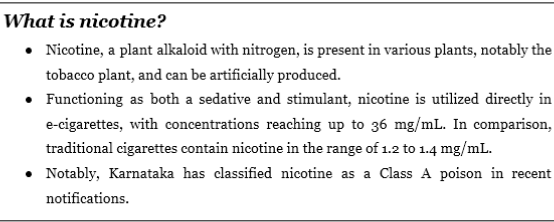E-cigarettes are electronic devices powered by batteries, designed to function by heating a liquid substance into an aerosol, which users then inhale and exhale.
The liquid in e-cigarettes commonly includes nicotine, propylene glycol, glycerin, flavorings, and various other chemicals.
Concerns with e-cigarette
- Nicotine in e-cigarettes is addictive and poses a risk to developing fetuses.
- Adolescent and young adult brain development can be harmed by nicotine exposure, which continues into the early to mid-20s.
- E-cigarette aerosols may contain harmful chemicals that can adversely affect lung health.
- Youth e-cigarette use is associated with the use of other tobacco products, including traditional cigarettes.

Associated health risks:
- The utilization of nicotine in e-cigarettes blurs the distinction between these devices and conventional cigarettes.
- The presence of nicotine solutions, recognized as a highly addictive substance, emphasizes the comparable addictiveness of e-cigarettes to traditional ones.
- The extent of health risks associated with e-cigarettes is contingent on their capacity to deliver nicotine.
- While nicotine itself is not a carcinogen, it possesses the potential to stimulate the growth of tumors.
- According to the World Health Organization (WHO), certain solutions within e-cigarettes and their emitted substances are classified as "toxicants," contributing to health concerns.
Summary of e-Cigarette Usage in India:
Status of e-Cigarettes in India:
During the period from 2016-17 to 2018-19, India witnessed a notable influx of e-cigarettes valued at USD 1,91,781, predominantly sourced from China, the US, Hong Kong, and Germany. Disturbingly, between 2017 and 2018, there was a substantial increase in the adoption of e-cigarettes, with a 78% surge among high school students and a 48% rise among middle school students.
Responding to the escalating concerns associated with e-cigarette use, the Indian government enacted the Prohibition of Electronic Cigarettes Ordinance in 2019. This ordinance enforced a comprehensive ban on all activities related to e-cigarettes, encompassing production, manufacturing, import, and sale. Violations of this ban could result in penalties, including imprisonment for up to one year or fines up to Rs 1 lakh for a first offense. Notably, India stands out among nations, with 65% of its population under the age of 35, as one of the few countries implementing a complete prohibition on the sale of e-cigarettes, signaling a robust stance against the potential health risks associated with their use.
Highlights from Recent Study on e-Cigarette Use:
- Despite the ban, 23% of educated youth (from a sample of 840 individuals) reported using e-cigarettes, which are available through online stores and local vendors.
- Approximately two-thirds of those aware of e-cigarettes perceived them as harmful and containing chemicals.
- Among non-users, 31% expressed curiosity about trying e-cigarettes, and 23% intended to use them in the following year, indicating a high level of susceptibility.
Arguments Against the Ban:
- The selective ban on e-cigarettes appears arbitrary when other tobacco products remain legal, raising questions about the exercise of executive authority.
- Advocates suggest regulating and taxing e-cigarettes as "sin goods" rather than imposing a blanket ban, treating them similarly to other socially and culturally accepted products.
- E-cigarettes are marketed as safer alternatives to traditional cigarettes, claiming to lack the carcinogens found in conventional tobacco products.
- The sudden rise in ITC shares following the e-cigarette ban raises concerns about a potential nexus between tobacco companies and the government.
- Considering the economic aspects, e-cigarettes are viewed as significant revenue sources for public coffers.
Argument in Favor of Ban:
- Smoking-related diseases pose a severe public health concern, justifying the ban as a preventive measure.
- E-cigarettes, touted as a direct source of nicotine, are argued to be more addictive than cocaine, with potential carcinogenic risks associated with pure nicotine.
- Despite claims of industry-government collusion, the global tobacco business is shifting toward e-cigarettes, dispelling allegations of a dubious nexus.
- The argument that e-cigarettes aid in quitting smoking lacks conclusive evidence, with medically-approved methods demonstrating higher success rates despite being more expensive.
- Total prohibition is deemed effective for e-cigarettes due to their small customer base, primarily in urban areas, as opposed to traditional cigarettes with a larger consumer presence.
- The concern that a ban would lead to revenue loss is refuted, as e-cigarettes are not locally manufactured, and the public health expenditure from related diseases would likely surpass potential revenues, similar to other "sin goods."
Way forward:
- Recognizing this positive trend, it is crucial to prevent e-cigarettes from potentially reversing the decline in tobacco consumption.
- The historical trajectory of tobacco usage, originating in British colonial practices and intensifying post-Independence, is acknowledged as a misstep that needs rectification.
- The present moment offers a crucial opportunity to correct this historical error and protect the upcoming generation from the harmful influence of the tobacco industry and its evolving products.
- The government's decision to prohibit e-cigarettes is viewed as a progressive step toward fostering a society free from addiction.
- This approach aligns with the broader objective of ensuring a healthier and safer environment for the generations to come.
- To mitigate e-cigarette uptake, there is a need for increased education on the associated harms of vaping, particularly targeting high-prevalence groups like educated adults.
- Enhanced monitoring and stricter enforcement measures could further contribute to reducing e-cigarette usage, safeguarding public health.
Conclusion
India's commendable achievement in curbing tobacco consumption, as evidenced by the notable decline highlighted in the second Global Adult Tobacco Survey of 2016, underscores the need to stay resolute in the face of emerging challenges. The historical origins of tobacco use, dating back to the British colonial era and its subsequent commercialization post-Independence, present an opportunity for corrective action. The ban on e-cigarettes, a pivotal decision by the government, reflects a forward-looking approach aimed at breaking the shackles of addiction and protecting the well-being of future generations.
As we navigate this critical juncture, it is imperative to recognize the potential threat posed by evolving products in the tobacco industry and remain committed to fostering an addiction-free society. The government's stance on e-cigarettes aligns with the broader vision of creating a healthier, safer, and more sustainable environment for our youth. By learning from the past and embracing a proactive strategy, we can collectively contribute to shaping a future free from the grip of harmful substances, ensuring the well-being and prosperity of our nation.

